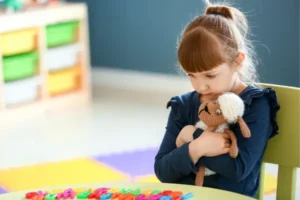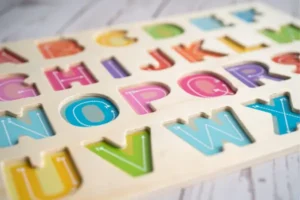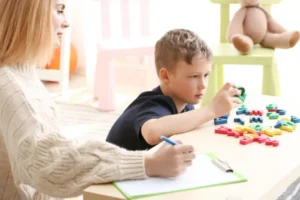Overview of the Topic
Communication is a fundamental skill that many children with autism struggle to develop. These challenges can range from delayed speech to difficulty with social interactions and understanding non-verbal cues. As communication plays a vital role in expressing needs, building relationships, and navigating daily life, addressing these difficulties early on is crucial.
Educational toys can be powerful tools in helping children with autism improve their communication skills. These toys offer interactive, engaging experiences that encourage verbal, non-verbal, and social communication, supporting children in overcoming barriers to effective interaction.
Purpose of the Article
This article will explore how educational toys can be used effectively to enhance communication in children with autism. We will highlight the types of toys that work best for improving language skills, social interaction, and overall communication abilities.
Why It Matters
Improving communication is essential for children with autism to better express their thoughts, feelings, and needs. Effective communication not only helps them in daily activities but also fosters stronger relationships with family, peers, and caregivers, leading to greater independence and quality of life.
The Role of Communication in Autism
Communication Challenges in Children with Autism
Children with autism often face significant communication difficulties. These may include delayed speech, difficulty understanding or using verbal and non-verbal cues, challenges with social interactions, and trouble expressing needs or emotions. Some children may be non-verbal, relying on alternative methods like sign language or communication devices. These communication barriers can impact their ability to form relationships, engage with others, and navigate daily life.
The Importance of Early Intervention
Addressing communication challenges as early as possible is critical for improving long-term outcomes. Early intervention helps children develop essential language and social skills, which can improve their confidence and ability to interact with the world around them. The sooner communication difficulties are identified and supported, the greater the chance of success in overcoming them.
How Educational Toys Can Support These Challenges
Educational toys can play a key role in supporting children with autism by promoting language, cognitive, and social skills. Toys that engage multiple senses (e.g., auditory, visual, and tactile) can help improve language comprehension and expression. Interactive toys that encourage repetition, imitation, or turn-taking provide opportunities to practice verbal and non-verbal communication. By integrating play with learning, educational toys create an environment where children with autism can build essential communication skills in a fun and engaging way.
Key Features of Educational Toys That Enhance Communication
Sensory Stimulation
Toys that engage multiple senses—such as touch, sound, and sight—are particularly beneficial for children with autism. Sensory stimulation helps children connect sensory experiences with words, reinforcing language development. For example, toys with different textures, sounds, or lights can encourage children to explore and interact, promoting communication through sensory discovery.
Interactive Elements
Interactive toys that encourage verbal interaction, repetition, and imitation are key for developing speech. Toys that prompt children to respond, such as those that ask questions or make sounds when buttons are pressed, encourage verbal communication and help children practice new words. Repetitive play with these toys can improve speech clarity and confidence.
Visual and Symbolic Learning
Toys with images, symbols, or visual cues support language development by helping children connect words to meanings. For instance, toys featuring picture cards or images related to specific words can improve vocabulary and comprehension. This visual support helps children who may struggle with verbal communication by offering a clearer, more tangible way to understand language.
Social Play and Role-Playing
Toys that promote turn-taking, sharing, and imaginative play help children develop essential social and conversational skills. Role-playing toys, like tea sets or dolls, encourage children to use language in social contexts, helping them practice communication through shared play. These toys also teach the basics of social interaction, such as listening, responding, and understanding social cues.
Types of Educational Toys to Improve Communication
Speech and Language Toys
Speech and language toys are designed specifically to enhance verbal communication. Examples include talking dolls, sound books, and apps that help with word formation and pronunciation. These toys encourage children to practice speech by repeating words or imitating sounds, promoting language development in an engaging way.
Sensory Toys
Sensory toys provide tactile, auditory, and visual stimulation that supports language learning. Examples include textured toys that children can touch and explore, or light-up toys that respond to touch or sound. These toys help children with autism connect sensory experiences to words, reinforcing language comprehension in a fun, interactive manner.
Interactive and Smart Toys
Interactive and smart toys incorporate technology to engage children in language practice. For example, smart tablets or talking toys with built-in speech recognition can prompt children to respond verbally. These toys encourage active participation and help children develop their language skills through interactive play, adapting to their learning needs.
Pretend Play and Social Toys
Pretend play toys, like tea sets, dolls, or action figures, encourage imaginative play and social interaction. These toys promote conversation and help children practice language in social contexts, teaching them how to take turns, ask questions, and engage in cooperative play. They also offer opportunities for role-playing, helping children with autism understand social cues and improve communication in real-life situations.
How to Choose the Right Educational Toy for Your Child
Assessing Your Child’s Communication Needs
To choose the right educational toy, start by assessing your child’s specific communication needs. Does your child need more verbal practice, like repeating words or forming sentences? Or would they benefit more from visual support, such as toys with images or symbols? If sensory stimulation is a key area, consider toys that engage multiple senses, like tactile or auditory toys. Understanding your child’s preferences and challenges will help guide your selection.
Consulting Professionals
Consulting with professionals, such as speech-language pathologists or occupational therapists, can provide valuable insight into your child’s developmental needs. These experts can recommend toys that are tailored to your child’s communication stage and help enhance their language skills. They can also advise on which types of toys would be most effective based on your child’s unique strengths and challenges.
Trial and Error
Since every child is different, it may take some trial and error to find the toys that best suit their needs. Experiment with a variety of toys, paying attention to your child’s responses—what excites them, what they engage with, and what helps them improve communication. With patience and observation, you’ll discover which toys are most effective in fostering language development and social interaction.
Benefits of Using Educational Toys for Communication Development
Enhanced Communication Skills
Educational toys help support both verbal and non-verbal communication by encouraging children to practice speaking, listening, and understanding. Through repetition and interactive play, these toys promote language development, improving vocabulary, sentence structure, and comprehension.
Increased Social Interaction
Toys that promote shared play, such as those that involve turn-taking or cooperative activities, help children with autism develop important social communication skills. By engaging in these social play scenarios, children learn how to initiate conversations, respond to others, and understand social cues.
Boosted Confidence and Independence
Mastering new tasks through play boosts children’s confidence and encourages them to express themselves more freely. As children interact with educational toys and experience success, they gain a sense of accomplishment, which fosters greater independence in their communication.
Better Family and Peer Interactions
Communication-focused toys encourage meaningful interactions between children and their families or peers. By facilitating verbal exchange and shared activities, these toys strengthen relationships and help children build connections with those around them, promoting social and emotional growth.
Real-Life Examples and Success Stories
Case Studies or Examples
Many children with autism have shown significant improvements in communication through the use of educational toys. For example, one child who struggled with verbal expression began to use more words after consistent interaction with a talking doll that encouraged imitation and repetition. Another child, who had difficulty with social cues, made progress in engaging with peers after regularly using a pretend play tea set that promoted turn-taking and conversation.
Parent and Caregiver Testimonials
“I was amazed at how quickly my son started mimicking the sounds and words from his sound books. It’s like he found a way to communicate that didn’t feel overwhelming,” says Sarah, a mother of a 4-year-old with autism.
“Using a smart tablet app with interactive speech games really helped my daughter expand her vocabulary. Now, she’s more confident when talking to us,” shares John, a father of a 6-year-old. These stories highlight how targeted educational toys can make a real difference in communication development for children with autism.
Conclusion
Recap of Key Points
Educational toys can play a crucial role in improving communication for children with autism. By engaging multiple senses, encouraging verbal and non-verbal interactions, and fostering social play, these toys help children develop essential language skills, build confidence, and improve social connections. Whether through speech-focused toys, sensory play, or imaginative role-playing, these tools can make a significant impact on a child’s communication abilities.
Encouragement for Parents and Caregivers
With the right educational toys, every child has the potential to enhance their communication skills. It’s important to remember that progress may take time, and what works for one child may not work for another. By being patient and persistent, parents and caregivers can support their child’s growth and development.
Final Advice
Be open-minded and willing to experiment with different types of toys to see what resonates best with your child. Consistency is key, and small steps in communication, when nurtured through play, can lead to big improvements over time.




